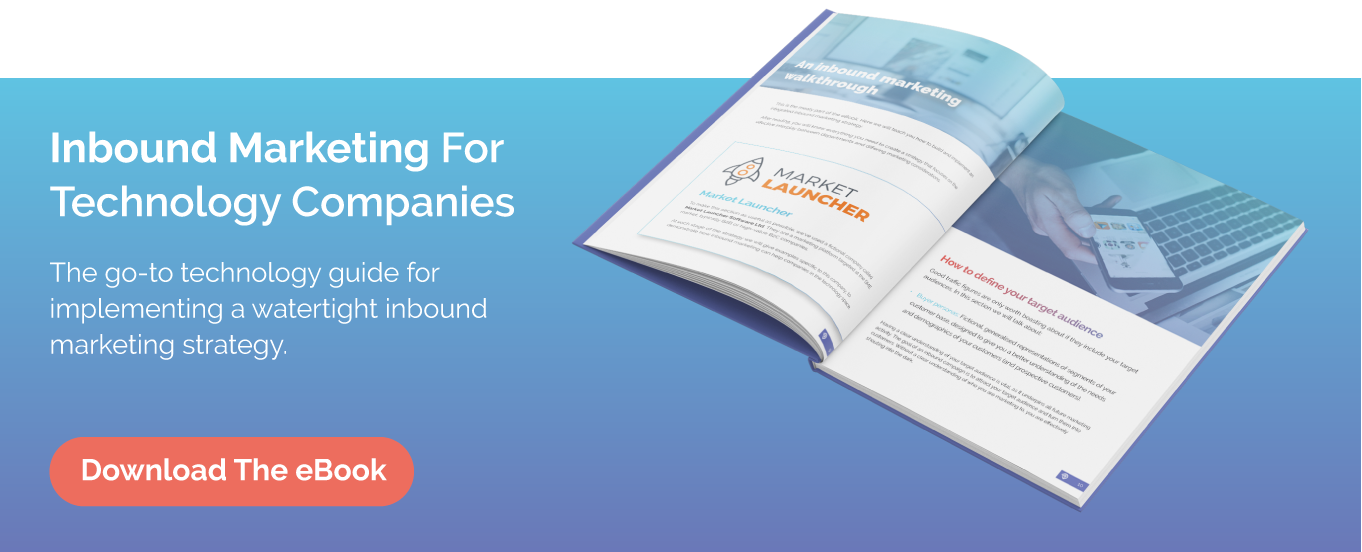If everyone loves a new SaaS product, why is it that the products don’t just sell themselves?
If only it were so easy.
Firstly, there are an enormous amount of competing products in the SaaSosphere
Secondly, even those SaaS products that do 'sell themselves' have had extensive marketing and product development behind them.
To make a SaaS success story means building a strong sales team, developing effective marketing, and implementing scalable goals at each step of the journey.
Here are the 3 key aspects to building a successful SaaS sales team.
- Work to a marketing plan
- What to look for when hiring SAAS Sales Reps
-
Reviewing success: setting SaaS goals and objectives
Work to a marketing plan
Successful sales can only happen when you have a marketing department creating the tools necessary to generate leads, alongside steps to ensure your SaaS product stays both relevant and valuable.
That means working to a clearly defined marketing plan.
Marketing for sales
According to The Cult Branding Company there are 52 types of marketing strategy. We are interested in the marketing plan, and how it exists to facilitate sales.
A SAAS marketing plan is where all the aspects of your business, including the product, sales, support and revenue model, will come together in one marketing-shaped bundle.
According to one successful marketer, this is where you formulate your plan for your product to 'sell itself':
It starts with attracting the right audience.
This means creating the right buyer personas to be targeting. Personas influence the overall look and feel of your product as well as dictating the type of content you are creating.
Then you manage customer expectations early.
If you are going to give them a call as soon as they sign up, or if you are going to charge them after their free trial ends, be clear about this and stick to what you tell them.
Remove sign-up inhibitors.
The fewer barriers you put in place that, the less likely they are to exit the process.
Make buying easy: Build your buying option into the product itself and set the customer up to buy it long before their free trial ends. If you don't ask, you don't get.

The best metrics
All metrics are popular in SaaS, and perhaps rightly so. The key to ensuring your sales team is prepared, is ensuring that everyone recognises the best SaaS metrics for your particular organisation.
Increasing SaaS revenue is important, as are growth, ROI and reducing churn rate.
One of the best metrics, according to Jason Lemkin, entrepreneur and SaaS founder, is LVR (Lead Velocity Rate). This is your monthly growth in qualified leads.
LVR measures how many people are visiting your site (or application) and taking action, either by taking advantage of a free trial or requesting more info.
Lemkin values this over other metrics because sales is a metric that lags. Sales is what you have done, not what you are going to do. LVR is a predictable, scalable metric: if you have a growth of 6% month on month then sooner or later your revenue will hit a million.
This is the benefit of the recurring revenue model of a B2B marketing strategy.
Selling 'success'
Kissmetrics believe that there is only one sales strategy you really need.
That strategy? Realising that SaaS sales isn't always about selling the product.
Successful SaaS sales also have a lot to thank their marketing department for, usually because they have created a notion of selling success.
Marketing departments have created a visual that focuses on aligning customer success with the SaaS product.
Positioning your product as one that can help people achieve success is almost a magic formula for successful sales, full stop.
After sales (AKA onboarding)
Onboarding is settling your new customer into either a paid subscription or ensuring that they enjoy a long term relationship with your SaaS.
It is ensuring that customers don't churn, especially in the first month!
Sometimes this can be a lengthy and invested processes. Zendesk is a good example: here, success is built through relationship and time-served onboarding.
At other times it can be hand-holding like Media Temple, a web hosting SaaS that will 'move' your website for you, which is a difficult and lengthy process even for experienced webmasters.
Whatever your onboarding strategy, it must reflect how you want your customer to view you from short-term to long-term.
What to look for when hiring SaaS sales reps
Your sales department exists to uncover customer pain and position your SaaS product as the solution they need to solve it.
Free trials, freemium and limited time discounts are SAAS pricing models that can all work, but some prospective customers who aren't easily persuaded by your shiny new button and time-saving features won’t always buy immediately.
For those, you need sales reps that have excellent product knowledge coupled with being able to quickly establish the value of solving the clients problem (or goal).
But good sales reps are few and far between, and they are in high demand .
They can talk tech.
I expect a sales rep from a tech company to know more about the tech than me.
If your sales rep isn't fluent in technology, they aren't going to be able to persuade an inquisitive or skeptical customer. They need to know how to use the product, and be at ease with discussing the finer points of the underlying tech and potential accompanying tech.
Sales Tip: Whilst the rep should have solid technical knowledge, it is important that they do not get pulled into a ‘support’ conversation before qualifying the suitability of the prospect.
Identifying the right kind of customer.
Your sales reps cannot just add any lead to their sales scores: they must be both qualified and a good fit for one of your buyer personas.
Anything but the ideal customer will increase your churn rate.
Sales Tip: The best reps aren't always the ones that sell the most, but sell mostly to the right kind of customer.
Your product is a value proposition.
Sales reps must understand that your product has value.
Recognising the need to convince prospects of this is paramount. This means relating the SaaS product with a clear value proposition, usually either time or money.
Great sales reps know the character of the people they are talking to, and know which ones are motivated by money and which people react well to time saved.
Sales Tip: Sales reps can convince leads your SaaS product is not just valuable it's essential to their growth.
LTV vs discounting
The natural inclination for sales reps is to make lots of sales.
In SaaS, it's not always the volume of sales that is important in generating ARR (Annual recurring Revenue), it's the LTV (Lifetime Value) of that customer that affects the bottom line.
Discounting price to achieve sales diminishes the value of the product - forever!
A great sales rep sees beyond achieving high volume sales at any cost because hard selling to prospects increases churn rate and discounting it reduces the value of the product.
Sales Tip: The sales rep's job is to justify your SAAS Pricing Strategy. Their key job is to make cost a null-issue.
When hiring, hire two
One of the best pieces of advice when building a successful sales team is the initial hire. You should be hiring your first sales reps in twos.
Taking the financial strain of hiring two sales reps can be daunting but is very often worth it to establish the reasons for success as well as the reasons for failure.
Hiring more than one rep will not only provide internal competition and motivation, it will also provide you with a real-time comparison into sales performance.
Sales Tip: Set up activity tracking and correlate sales performance. Identify what type of activity and what volume drives success.
Reviewing success: setting SaaS goals and objectives
Sales objectives
HubSpot has a very clear goal-oriented approach to selling its SaaS inbound marketing product. For its sales team, it likes to ensure goals are predictable so it has scalable revenue growth. This means:
- Hiring the same type of sales rep
- Training each in the same way
- Providing the same amount of leads (quality and quantity) to each
- Ensuring leads are worked using the same process.
Defining the sales process
HubSpot’s Head of Sales, Mark Roberge, has a clear policy when it comes to ensuring all sales are on the same page:
- Make sure that everyone is using the same terminology
- Onboard all sales in the same way, even if it takes tim
This means that all SaaS sales reps (and those managing customer success) have a clear roadmap when it comes to setting up and closing leads:
- Research: prepare for the sales process
- Prospect: get to connect
- Connect: schedule the assessment
- Qualify: determine the lead’s willingness to demo
- Demo: demonstrate the value of the software
- Close: deal with objections and sign them up.
All the time, according to Roberge, HubSpot is analysing every sales rep’s ability to complete each stage and their effectiveness in doing so. It creates a powerful set of internal sales metrics that is often hard to argue with when hiring.
Goal-setting
WideAngle is a SaaS provider for 1:1 meetings and performance reviews. Who better to seek advice from on the role of goal-setting for its SaaS sales teams.
It highlights 7 metrics and goals that your SaaS sales reps should be hitting, including:
- Metric #1: Leads: the best sales teams bring in a steady quantity of qualified leads. Goals: 10 new leads per day.
- Metric #2: Calls: telephone calls have been a sales staple since its invention, talking to prospects is key to creating rapport and moving them along the sales funnel. Goal: 25-50 calls a day.
- Metric #3: Conversations: these highlight important information that can either qualify or un-qualify a lead. It also indicates how well sales reps can convert to free trials or demos. Goal: 5 Conversations every day.
- Metric #4: Scheduled demos: getting that one-to-one screen share isn't easy to close. Goals: 1 demo a day.
- Metric #5: Completed demos: demos take time, but completing them increases the chances of converting. Goal: 1 completed demo a day.
- Metric #6: Creating opportunities: once a sales rep has enough data to prove they are serious about buying, create an opportunity. Goal: 1 opportunity created a day
- Metric #7: Revenue: the end result of all those metrics. This will show whether your sales reps are achieving the previous metrics or if they aren't closing enough deals. Goal: Depends on your product and pricing. Only you can decide what is achievable and scalable.
While your SaaS organisation might have many other aspects it needs to monitor, keeping on top of key sales metrics and sales reps means you are more likely to build a sales team that performs and achieves through customer acquisition.
Building the best SaaS Sales team is a delicate balance between using hard scientific facts you gain from your sales funnel with the hard ability to sell and up-sell.






